|
Cameo Gems
by
Bob Brooke
Cameo glass, a revival of
a technique demanding great skills and known to the Romans, became one
of the most important features of the English glass industry in the
latter part of the 19th century. This particular form of decorating
glass has always been a product demanding great skills.
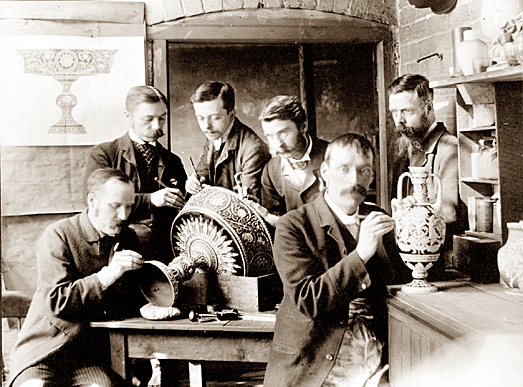
The Origins of Cameo Glass
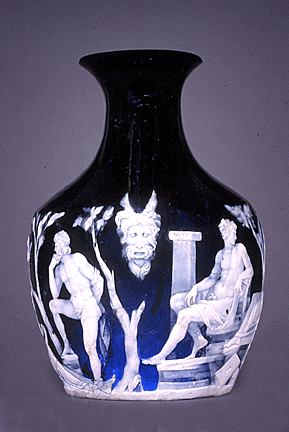 Cameo
glass first appeared in ancient Rome around 30 BCE where it was an
alternative to luxury engraved gem vessels in cameo style that used
naturally layered semi-precious gemstones such as onyx and agate.
However, the precise techniques used by the Roman artists have been lost
to history. Cameo
glass first appeared in ancient Rome around 30 BCE where it was an
alternative to luxury engraved gem vessels in cameo style that used
naturally layered semi-precious gemstones such as onyx and agate.
However, the precise techniques used by the Roman artists have been lost
to history.
Roman cameo glass was fragile, and thus extremely rare—much more so than
natural gemstone cameos produced from the 3rd century BCE onward. Only
about 200 fragments and 15 complete objects of early Roman cameo glass
survive. Based on the limited number of surviving pieces, cameo glass
seems to have been produced during two periods—the early period from
about 30 BCE to 60 CE, and then for about a century from the late-3rd
century to the period of Constantine the Great and his sons.
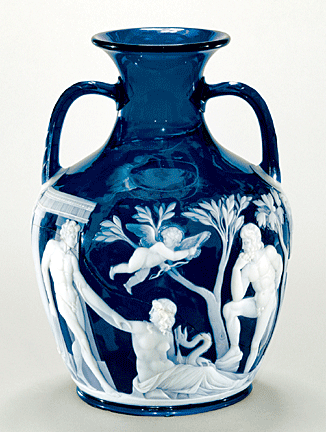 Roman
aristocrats owned and used cameo glass from the latter period. The
Portland Vase, the most famous example, excavated from the tomb of the
Emperor Septimius Severus, would have been a 200-year-old antique to
him. The most popular color scheme for objects from the early period was
white over blue, but archaeologists have discovered other colors, such
as the white over black, imitating the onyx of the Portland Vase. In the
early period usually all layers are opaque. By contrast, in the later
period, glassmakers added a translucent colored overlay over a virtually
colorless background, perhaps imitating rock crystal. The surface of the
top layer elements was flat rather than carved as in the earlier group
of pieces. Roman
aristocrats owned and used cameo glass from the latter period. The
Portland Vase, the most famous example, excavated from the tomb of the
Emperor Septimius Severus, would have been a 200-year-old antique to
him. The most popular color scheme for objects from the early period was
white over blue, but archaeologists have discovered other colors, such
as the white over black, imitating the onyx of the Portland Vase. In the
early period usually all layers are opaque. By contrast, in the later
period, glassmakers added a translucent colored overlay over a virtually
colorless background, perhaps imitating rock crystal. The surface of the
top layer elements was flat rather than carved as in the earlier group
of pieces.
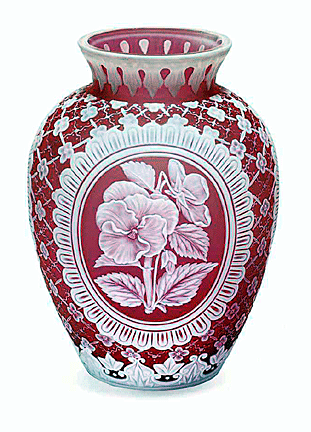 In
contrast, English cameo glass of the late 19th century had classical
inspiration with figural decoration compared to cameo work produced
elsewhere. What naturalistic decoration there was tended to be
overshadowed by Classicism. In
contrast, English cameo glass of the late 19th century had classical
inspiration with figural decoration compared to cameo work produced
elsewhere. What naturalistic decoration there was tended to be
overshadowed by Classicism.
Cameo glass first appeared in England after the Great Exhibition of 1851
and was usually the work of local craftsmen in the Stourbridge area,
which was the center of 19th-century English glassmaking. It too the
form of cased or flashed glass, using several layers of glass in the
manufacture of the vessel using an opaline glass on a colored ground
with a matt finish, the opaline shape being filled with colored glass
and then carved. The manufacturer sent the blanks to a decorator's
workshop, where artists partially removed the outer layer, using small
steel rods to carve the relief. They obtained shadows by controlling the
density of the decoration.
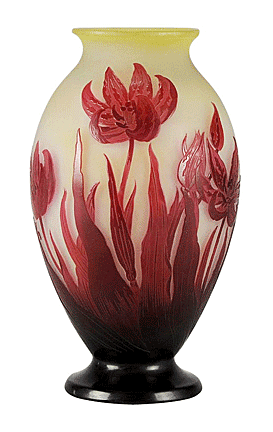 Originally,
this method of production required such a high degree craftsmanship and
technical competence that it was never viable commercially. Eventually,
with the rise in demand for cameo glass, some glass manufacturers
introduced methods of mass production. Workers treated the glass blanks
with acid, then used an engraving wheel to produce cheaper cameo work
for a mass market. Glass engravers did the relief work on a thinner
base, so that there was less ground to remove for shadowing and
commercial pieces could be produced on a large scale. Originally,
this method of production required such a high degree craftsmanship and
technical competence that it was never viable commercially. Eventually,
with the rise in demand for cameo glass, some glass manufacturers
introduced methods of mass production. Workers treated the glass blanks
with acid, then used an engraving wheel to produce cheaper cameo work
for a mass market. Glass engravers did the relief work on a thinner
base, so that there was less ground to remove for shadowing and
commercial pieces could be produced on a large scale.
The Cameo Glass Technique
Cameo glass was a glass making technique in which workers fused several
layers of colored glass together, removing the outer layers using wheels
or drills or by acid-etching in which acid dissolved the outer layer.
This usually consisted of white opaque glass figures and motifs on a
dark-colored background.
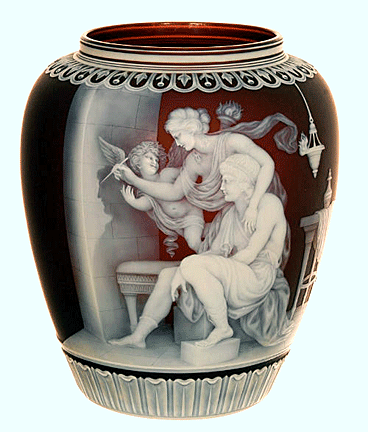 In
ancient Rome, glassmakers used drills and wheels to remove the unwanted
white or other top layer—wheel-cut decoration on glass of a single color
was very common at the time. In the case of a "three-layer" cameo,
another layer of glass sat on top of the white opaque one, and further
layers were possible. One Roman piece used a record six layers. In
ancient Rome, glassmakers used drills and wheels to remove the unwanted
white or other top layer—wheel-cut decoration on glass of a single color
was very common at the time. In the case of a "three-layer" cameo,
another layer of glass sat on top of the white opaque one, and further
layers were possible. One Roman piece used a record six layers.
In contrast, with the revival of cameo glass in the 19th century,
manufacturers often used a combination of drilling and acid-etching.
Artists would cover the figure areas with a resist layer of wax or
bituminous paint, then repeatedly dip the blank in hydrofluoric acid.
They would then do the detailed work with wheels and drills, before
finishing and polishing.
Outstanding English cameo glass artisans were Philip Pargeter and John
Northwood, and George Woodall. Classicism influenced all of their
designs. But the most influential piece was the Portland Vase, made in
the 1st century CE., which went on exhibit in the British Museum in
1810. It provided an example for English pioneers in cameo work and an
impetus for the development of English cameo glass. Unfortunately,
vandal smashed the original in 1845.
John Northwood
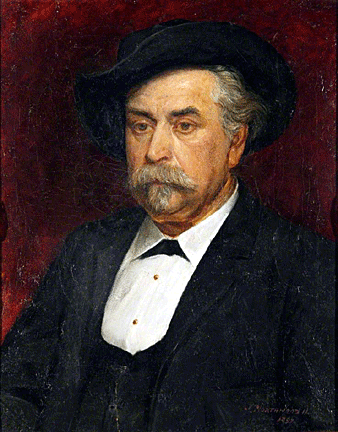 The
firm of Richardson of Stourbridge produced highly decorative and
experimental forms of glass and was particularly skilled in the use of
the acid etching process. They also employed John Northwood, the first
glassmaker in England to produce cameo glass using the classical
pattern. The
firm of Richardson of Stourbridge produced highly decorative and
experimental forms of glass and was particularly skilled in the use of
the acid etching process. They also employed John Northwood, the first
glassmaker in England to produce cameo glass using the classical
pattern.
John Northwood, a great admirer of Greek art, came from Wordsley and
joined the Richardson firm around the age of 12, painting on glass in
Richardson's decorating shop. He had been a prize student at Stourbridge
School of Art and was greatly influenced by the trend towards
museum-inspired revivalism and by the work of the Neoclassicists. He
made a serious study of classical design and by 1861 he and his brother,
Joseph, had set up a decorating workshop in Stourbridge, using acid
etching to produce highly elaborate ornamentation on glass.
 In
1876, Northwood and his cousin, Philip Pargeter, created a copy of the
Portland Vase. From 1873 to 1876, Northwood made endless experiments in
technique and in the use of various engraving tools to reproduce the
historic vase, which he displayed at the Paris Exhibition of 1878. In
1876, Northwood and his cousin, Philip Pargeter, created a copy of the
Portland Vase. From 1873 to 1876, Northwood made endless experiments in
technique and in the use of various engraving tools to reproduce the
historic vase, which he displayed at the Paris Exhibition of 1878.
The popularity of cameo glass in general and the Portland Vase in
particular caused several factories to begin production of cameo glass
to meet the public’s demand for it.
The glass produced at this time period ryas strongly classical and
showed the overriding influence of the Portland vase, but in the 1880s,
when the taste for cameo glass became more widespread, manufacturers
produced it on a more commercial scale, and in some cases used floral
decoration.
Thomas Webb and Sons
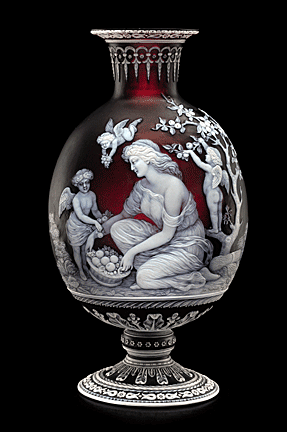 In
1877, Thomas Webb and Sons employed the brothers George and Thomas
Woodall. The Woodall’s had been apprenticed to John Northwood while he
recreated the Portland Vase. They refined the techniques and produced
many beautiful pieces of cameo glass for Thomas Webb. This encouraged
Webb to send George Woodall to Europe and to art school to study. In
1877, Thomas Webb and Sons employed the brothers George and Thomas
Woodall. The Woodall’s had been apprenticed to John Northwood while he
recreated the Portland Vase. They refined the techniques and produced
many beautiful pieces of cameo glass for Thomas Webb. This encouraged
Webb to send George Woodall to Europe and to art school to study.
In 1884, Webb started to produce commercial cameo glass, using the
wheel, instead of relying entirely upon carved decoration, with great
emphasis upon shadow, caused by deep cutting of the overlay. The
engravers used acid and painted the pattern in acid resistant.
The work done by the Woodalls themselves was mainly figurative and more
personal in approach than the work produced by Northwood, although the
Woodalls also relied heavily upon classical inspiration.
Cameo work represented a comparatively short-lived fashion which was
virtually over by the beginning of the 20th century.
<
Back to Antiques Archives
Next Article > |
